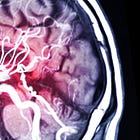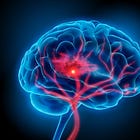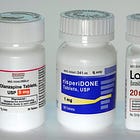Good To Know: April 10, 2025
Aspirin for sepsis, C. auris, CDC watching ceftriaxone, nerinetide for strokes, more
If this email gets cut off, click the title to view the whole post online or in the Substack app. -Ed.
SEPSIS
Aspirin For Sepsis (ASP-SEPSIS trial)
Could a simple aspirin help cure sepsis?
No. Of course not.
But like acetaminophen, aspirin is cheap and widely available and has anti-inflammatory properties, so it’s catnip for clinical trialists.
Among 166 patients with “sepsis” who were randomized to aspirin 200 mg or placebo at five ICUs in Brazil, those receiving aspirin had no improvement in organ failure scores or other outcomes. (Almeida et al Crit Care Med 2025)
They did have more major bleeding (10% vs 1%), often requiring blood transfusions.
The safety monitoring board then shut down the study before its target enrollment of only 218 patients. “Sepsis” cases were identified using the Sepsis-3 criteria.
Most Clinicians Ignore New “Steroids-For-All” Septic Shock Guideline
In 2024, the major U.S. critical care society recommended steroids be given to virtually all patients with septic shock. Prior advisements had been to provide patients with steroids more selectively (e.g., for those with a persistent or increasing vasopressor requirement).
Following the guideline would represent a significant practice change for most physicians, according to a new study.
Only about one-quarter of 5,300 patients with septic shock received corticosteroids at 26 ICUs at nine UPMC hospitals between 2018 and 2020. (Soni et al Crit Care Explorations 2025). The study could not assess more recent prescribing patterns since the guideline was issued.
Candida auris: still scary (but not more so)
Candida auris is an emerging pathogen that is usually resistant to multiple antifungal drugs and is often a final fatal infection in vulnerable patients (e.g., those with immune suppression or long ICU stays).
Media reporting of a recent study hyped C. auris cases as rising throughout the country.
They are rising, but the study (Rosa et al American Journal Infection Control 2025) only showed that they rose significantly at Jackson Health Systems in Miami from 2020 to 2023, which is not news (the CDC’s last tranche of national surveillance data included 2023).
There was in truth only a small rise in cases most recently, from 107 in 2022 to 122 in 2023.
Most hospital microbiology labs do not reliably detect C. auris, which is often misidentified as other Candida species. The CDC or an authorized reference lab can reliably identify the organism, but most cases go unrecognized outside of formal surveillance programs.
Micafungin is the preferred first-line drug when C. auris is suspected, but resistance to the echinocandin class also seems to be emerging.
CDC Investigating Adverse Events After IV/IM Ceftriaxone
CDC is enlisting state health authorities’ surveillance after receiving multiple reports of serious adverse events, including cardiac arrest, after ceftriaxone injections. They requested cases dating back to September 2024.
According to state public health reports, there were initially about 10 cases isolated to the southeastern U.S. (and particularly Alabama). State health authorities then reported several adverse events in Georgia associated with ceftriaxone.
No definite connection was identified, and there was no caution issued against using ceftriaxone. Possible adverse events can be reported to state health authorities who will communicate with CDC.
Pennsylvania’s advisory (many other states have issued these)
STROKE
Nerinetide for acute ischemic stroke (FRONTIER and ESCAPE-NEXT)
Nerinetide is a neuroprotective agent that inhibits neuronal excitotoxicity. The peptide appeared effective at reducing brain infarct size in animal models of acute ischemic stroke, when administered very early after vessel occlusion.
In the randomized ESCAPE-NEXT trial (Lancet 2025), nerinetide did not improve functional outcomes when administered within 12 hours of ischemic stroke onset in patients who then underwent reperfusion therapy (n=850). This followed the also-negative ESCAPE-NA1 trial (Lancet 2020).
That left open the possibility of a benefit of nerinetide if administered much earlier in the course of ischemic stroke.
In the phase 2 FRONTIER trial (Lancet 2025), 532 people with suspected stroke were randomized to nerinetide or placebo given by paramedics within 3 hours of stroke onset. Most patients had ischemic stroke.
The trial was negative overall. However, among patients with ischemic stroke who later got reperfusion therapies (thrombolysis or endovascular thrombectomy, or both), nerinetide was associated with improved functional outcomes (adjusted odds ratio 1.8, 1.03–3.28; adjusted risk ratio 1.29, 1.01–1.65).
Alteplase for late-presenting posterior circulation ischemic strokes (EXPECTS trial)
Recent randomized trials have explored the possible benefits of thrombolytics in disabling acute ischemic stroke when administered outside the commonly accepted therapeutic window of 4.5 hours after symptom onset.
Those trials, which we have reviewed here in detail, generally enrolled only patients with large vessel occlusion in the anterior circulation:
It’s unclear if late thrombolytics are beneficial for ischemic strokes in the posterior circulation.
In the EXPECTS trial (NEJM 2025), 235 patients with ischemic strokes in the posterior circulation were randomized to standard care with or without alteplase (tPA) given between 4.5 and 24 hours after onset of stroke symptoms. After 90 days, tPA patients had greater functional independence.*
*in China. Not placebo-controlled (not fully blinded).
FDA Approves Tenecteplase (TNK) For Ischemic Stroke
Neurologists have been using TNK off-label for years as an alternative to tPA for acute ischemic strokes. TNK is easier to administer and might cause fewer intracranial hemorrhages. After numerous clinical trials suggested equipoise with tPA, including the 2022 AcT trial, FDA approved TNK for ischemic strokes in March 2025.
POLICY
CDC Suggests NPs and PAs Could Read Chest Films
The CDC is considering letting nurse practitioners and physician assistants become professional “B readers” of chest radiographs for the purposes of occupational evaluations (e.g., work-related pneumoconiosis).
The American College of Radiology wrote a letter of opposition to the move.
AND ALSO
Haldol in the ICU
A new meta-analysis of randomized trials found haloperidol provided for “ICU delirium” had no significant effect on patient outcomes other than reducing ICU stay by one day.
However, the analysis lumped together 2863 patients with both hypoactive and hyperactive (agitated) delirium, who probably have very little in common besides being in ICUs.
The meta-analysis follows others in 2019 and 2023 that suffer from the same weakness.
A flawed clinical construct (“ICU delirium”) that’s also easy to use (nurses do the CAM-ICU assessments) can produce enough research to fill entire library aisles. But is anything being learned? When aggregated and circularly cited enough times by enough influential authors, these simulacra of knowledge are passed along to trainees as dogma. The actual entity meanwhile remains even more benighted than if it had never been studied, because now it is buried under a heap of misdirecting concepts.














I am afraid we are forever stuck in useless clinical constructs